Media | Articles
What’s your best roadside-repair story?
Our According to You series has really brought out the best in you, dear reader of all things Hagerty Media. Last week’s question prompted some entertaining and surprisingly insightful responses, and today we hope to get the same level of responses with this question:
What’s your best story about a roadside repair?
For those of us who travel on a regular basis, this question is either very easy or very difficult to answer. Mishaps and malfunctions can happen anywhere, and the more you drive, the more stories you have to tell.
For me, I am light on stories, as I rarely use my old cars to venture too far away from city streets or suburban roads/stroads. But when I do hit the highway for far away zip codes, I pack spare parts relevant to whatever car I may be driving.

The photo above is my 1995 Lincoln Mark VIII LSC with its spare alternator, and Constant Control Relay Modules (CCRM). The alternator is remanufactured and the CCRMs are junkyard finds. This is certainly an odd gathering, but remanufactured alternators are all of dubious quality for long term owners like myself (they only last 1-5 years in my experience) and CCRMs are unique to the late-93 to 1995 Lincoln Mark Series with zero parts interchangeability with other Fords.
Marketplace
Buy and sell classics with confidence
Having these bits around gives peace of mind. While I can likely get the alternator anywhere, it’s better to swap it out in less than 30 minutes, instead of waiting hours for a tow to the nearest town to get the ball rolling with a local mechanic. Or local parts stores. Or local junkyards in hopes of finding an “unobtainum” relay module. I want none of this, so these parts (and tools for installation) live with my luggage in the trunk.
Just about anything else that can leave me stranded is likely found locally, so with these in my trunk I feel safe and secure going just about anywhere in this car. And what a ride it is! Maybe one day my 32-valve bullet train will actually break down on the highway, leaving me with a story worthy of an answer to this question. But for now, I have nothing…so I hope you can help us out:
What’s your best story about a roadside repair?
***
Check out the Hagerty Media homepage so you don’t miss a single story, or better yet, bookmark it. To get our best stories delivered right to your inbox, subscribe to our newsletters.
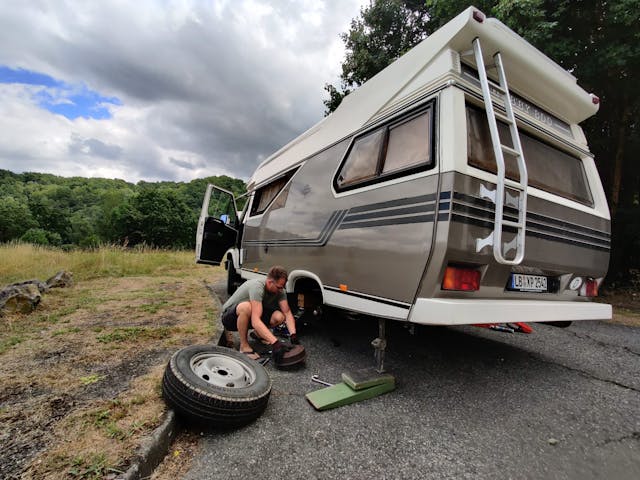
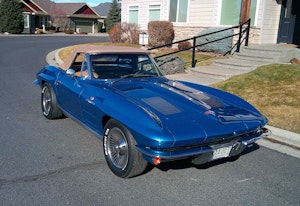
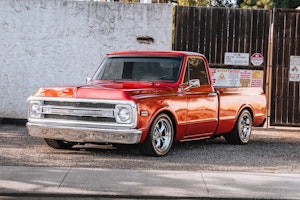
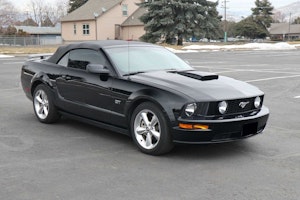

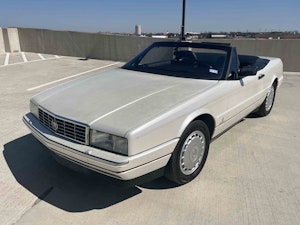








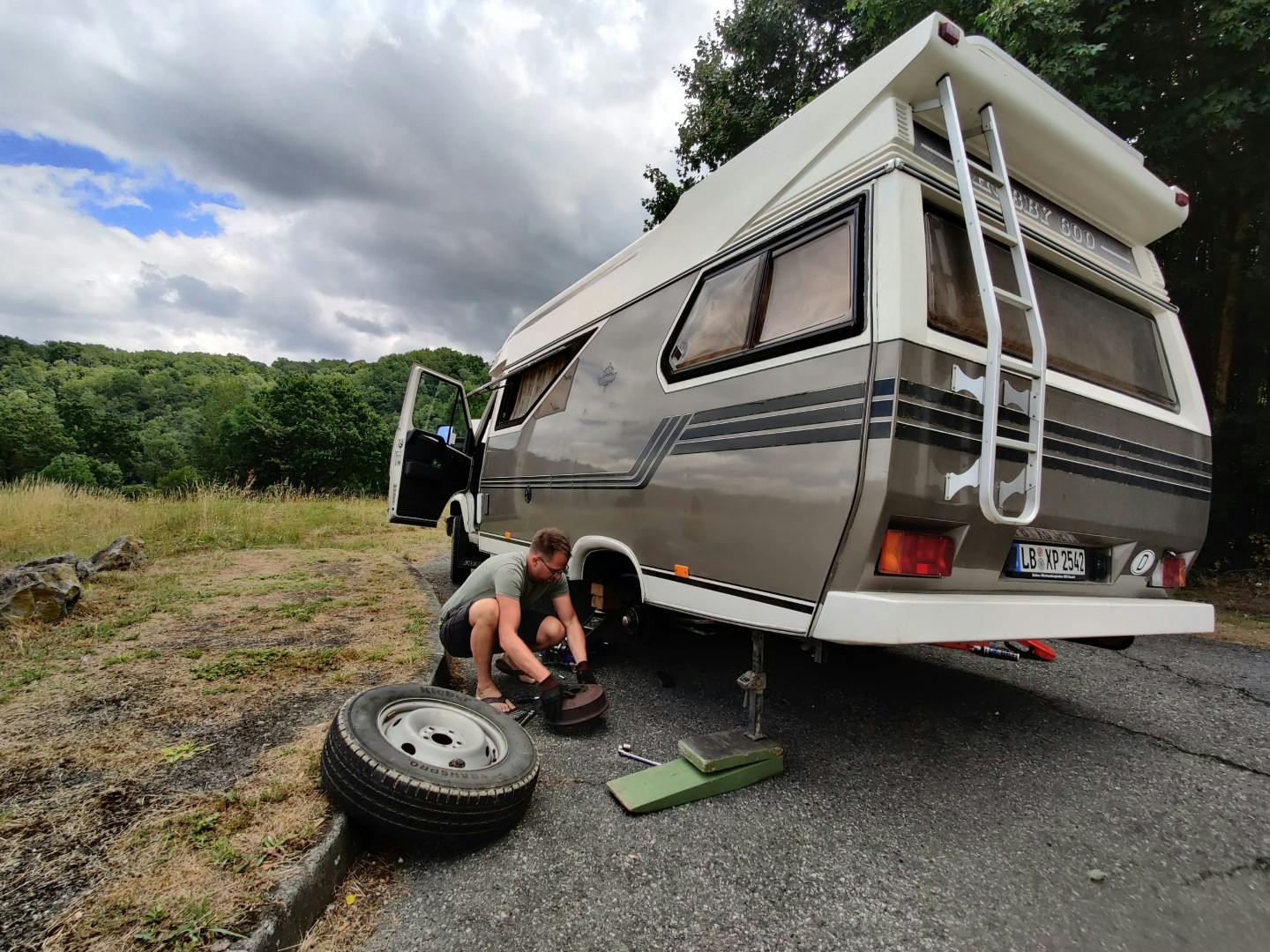
Back in 1974, I had a Pinto station wagon. While driving from Texas to New England late at night, the throttle became disconnected from the carburetor. Not having a flashlight to use under the hood, I disconnected the driver’s side headlight, removed it from its mount, and plugged it back in inside the engine compartment. Now having all the light I could ask for, I quickly determined that a nut had backed off the linkage, allowing the linkage to drop off the carburetor. Luckily, the nut dropped down onto the engine mount not the road, so I quickly reinstalled it and was on my way.
Another interesting repair, same car, happened when my wife called me at work to say the car broke down alongside Loop 410 in San Antonio. The engine had quit while she was driving and wouldn’t restart. I drove there and took a look- the cogged belt that drove the cam had broken. I drove home and got some tools, drove to the parts store for a belt, and went back and installed it right there beside the interstate. Took maybe half an hour tops. Fortunately it was a non-interference engine, so no valve damage. You can’t do that kind of thing with today’s cars, but on the other hand, you probably don’t need to because they are more reliable.
I have a strong need to know what type of bitchen hipster motorhome is having it’s tire changed while balancing on the sketchy floor Jack?
This one: https://www.hagerty.com/media/maintenance-and-tech/how-to-quit-worrying-ditch-your-job-and-ramble-europe-in-a-90s-spacevan-part-2/
That’s more than a “tire change” Jim! He’s got the brake drum off! Can’t imagine what happened!
Not to pile on the Pinto, but in the early ’70s three of us were crammed into a Pinto hatchback driving from Georgia to Albuquerque. It was early evening and things were humming along when the car just stopped running. I knew less about cars then than I do now but I have always relied on dumb luck to save my a**. We lifted the hood and couldn’t see anything obvious. We weren’t out of gas, there wasn’t an albatross stuck in the air intake, etc. On a hunch I pulled the distributor cap and had my friend turn the engine over. I happened to notice that the cam follower on the points was flapping around, not opening and closing the points as it should. I got some duct tape and tied it back together in its original “L” shape and lo and behold the little baby blue bomb burst into life. We were able to drive it another 15-20 miles to a small town where a guy who was about to go home for dinner took pity on us and installed a new set of points.
It’s always better to be lucky than good.
I was helping a friend on a Tow run. All was going good till 12:30 at night the tow truck died.
We had a Road Runner on the back. We sat for a bit thinking about how to resolve this. I came up with the idea I would get in the Road Runner and use the gas as my buddy steered and brakes. We had about 4 miles to go with no traffic and we got it in.
Another was a F250 stuck in reverse. Well It was 6 AM in Akron Ohio and no traffic and unable to get it out of gear I decided to back it up down Main St for about a mile and a half.
I did get pulled over and the officer asked what I was doing. I explained and he said Ok and went on.
Recently I had my sons car lose a battery. I got it jumpstarted but expected trouble as it was a gel cell battery that normally just flat fail.
I drove it home and as I did things stopped working. I already had the air and radio off but the stability control, then the air bags then the speedo and finally it locked in 3 gear. I got it home and a new battery fixed it all.
I had an issue with a Buick on the same route. The thermostat stuck. I knew what was wrong but the road side was no place to fix it. I would shut it down and coast them cool them start run and coast. 1.5 hours I got it home with no damage.
I do few road side repairs but I do fly in some crippled crafts that make it like a wounded B17 in the war.
Years ago my brother was driving home from a remote oil rig at -40 (F and Celcius are the same at that temp.) The propane fuel on his truck froze up, so he was stranded in the middle of nowhere. He emptied the windshield washer bottle and filled it with gasoline, then stuck the washer hose into the carb. He managed to make it to safety by squirting gas into the carb.
The only car that ever stranded me by the side of the road was my Lincoln Mark VIII. I’ve driven on 2000 mile trips with half century old Hudsons, LaSalles, Cadillacs, and many old Chryslers. None of these cars ever quit on a trip.
The Lincoln suffered multiple alternator failures in my last year of ownership. It’s a Mitsubishi alternator, not shared with other Fords. They used it because a Ford alternator wouldn’t fit the Mark VIII engine. Rebuilt units were the only alternative. The second Mark VIII alternator stranded me in Chicago, which has only 1 Lincoln dealer. The Lincoln alternator had a 1 year warranty. In the next year I had 8 alternator failures, all covered by warranty. I was stranded in Erie, PA for 3 days because the first alternator was dead on arrival. Multiple failures occurred close to home, so I could limp to the Lincoln dealer. A couple of times the new alternator was dead on arrival. Every dealer checked the car over thoroughly and found no faults.
I suffered multiple failures of the tape player on trips. The turn signal switch failed, causing the brake lights not to work, which in turn resulted in a ticket by a New York state trooper.
I finally decide that a luxury car that couldn’t be relied on to go more than 30 miles from home wasn’t worth having. I don’t care how nicely the Mark VIII went down the road, life was too short to spend it in Ford or Lincoln dealerships.
I had a Jeep YJ and had recently been working on it. I must have forgotten to tighten the distributor cap, and it came loose and broke the rotor – which would no longer stay in place (rotationally).
This was before the days of cell phones, and I was stuck out in the country at night.
I was able to rig it well enough to get it to stay in place by jambing a twig between the rotor and it’s shaft.
Many years ago on a run to St. Jovite (home of the Le Circuit Mt. Tremblant) the tandem axle trailer carrying my race ready MGB trailer siezed a wheel bearing. Onto the shoulder to effect a repair, I noticed a wrecking/scrap yard only a few meters from the stranded trailer. As I nominated myself to stay with the rig and send my crew off to find a tire, I had a bit of time to kill. I’ve have always liked to roam around wrecking yards (when that was still possible!), so I headed towards the entrance and got maybe a few yards in when I heard the sound of a chain unraveling! Realizing that a junk yard dog was likely attached to that chain, I started to run, boosted by adrenaline. Unfortunately, not quite fast enough as the dog sunk his teeth into by backside just as it reached the end of its chain, got yanked backwards and let go of me. Spent a lot of time standing over the next few days, except when in the race car!
It would be hard to beat the Big Bang Theory geeks igniting a historical owned conversion van in an attempt to change a flat tire.
I used to drive my 1929 Model A from St. Petersburg to the Daytona Speedway on Thanksgiving afternoon after having TG dinner. Obviously, I stayed far off I-4. I was taking 301 north as it got dark when the car began missing. Not one cylinder but the entire engine. Then it would run again like nothing happened. As it got darker, it began more frequently and I decided to pull into the next place I could. Fortunately, there was a little convenience store all lit up in the middle of nowhere and as I pulled in, it quit completely as I coasted into a spot underneath a light. Having learned that 95% of carburetor problems are electrical, I began trouble shooting. A group of Mexican migrant workers pulled in and they jumped right in helping me by holding flashlights, etc. Then they had to leave and as they did a group of five or six guys on Harley’s pulled in. They also came to the rescue. By then, I’d been through all the obvious solutions but still hadn’t found the problem so I was tracing the wiring inch by inch when I found the problem. When I converted the car to 12V negative ground, I’d installed my ballast resistor on the inside firewall above the throttle pedal and had kicked a wire loose. It had made intermittent contact until it didn’t. As usual, my problem was self inflicted but I sure appreciated all the folks who jumped in to help that night.
It was the early 1970’s. My sister-in-law had a brand new triumph GT6. She had just left our house when we got a call. The car had just guit. It would crank, but not start. The fuel line from pump to carbs somehow had a hole in it and was pouring fuel on the block. I stood there and scratched my head. Here it was the middle of the night on a back road with little to hhno traffic. I took one of the windshield wiper hoses attached it to the pump and then the carb inlet. I twisted two of her hairpins on each end with a pair of pliers. She drove home from there about twenty miles. She said she called her mechanic the next day and explained the problem. He said he would send a tow truck. She said don’t bother I’ll drive it over! She said he just stood and starred at the repair for about five minutes shaking his head.
My good friend had a 1970 Chevy van with a 350 that stopped running about 5 miles from his house. We did a little diagnostics and confirmed we were not getting fuel to the carb. We did have a 5 gallon gas can full of fuel, and a milk jug. We filled up the milk jug with gas, removed the dog house and air cleaner, and I held it over the carb. I then poked a hole in the bottom so the fuel would run out into the carb. Made it all the way back with no issue, but driveability was not great. Sometimes you have to do what you have to do.
It starts with a 1965 Dodge Coronet station wagon that I bought in 1978 for $75. What could go wrong? One warm spring day I got it in my head that it would be a good idea to pick up my girlfriend from her apartment in Brooklyn, NY and take a drive to Cape Cod, MA for a few days of camping, where my outdoor survival and all-around woodsman skills would no doubt impress this young city girl. 3 blown retreads later, we’re still clanking up to the Cape when a deluge of hot antifreeze starts pouring into the car from under the dash. Pulled over, popped the hood, and went to work rerouting the hoses back into the block, bypassing the heater core that was no doubt the cause of my boiled foot. (Note to the kids out there….I wish it was still a possibility to buy a used piece of junk for $75 that provided you with basic, but questionable, transportation and a never ending series of learning experiences. You never left home without jugs of water, cans of oil, bailing wire, duct tape, and a few tools to help you limp out of any situation.) Finally made it to Nickerson State Forest, where I couldn’t start a fire, set the tent up wrong, dropped the thermos of cocoa (they were lined with glass back then), and discovered that the woods in Cape Cod were a heck of a lot colder than the streets of NY that time of year. But I guess my girlfriend was awed enough by my ability to get that rolling bucket of trouble to make the round trip, that she consented to marry me some 40 years ago. (My wedding vow included a few words about never going camping again, but still….). All in all, not a bad return on my 75 bucks.
In August 1974 my new wife and I were on our way to Colorado from Illinois avoiding the Interstates – when we got within sight of Pikes Peak, I pulled our 1971 Fiat 850 Spider onto the shoulder to get out for a picture. When I went to start the car after the picture, it wouldn’t start, just the starter clicked but no turning of the engine. I assumed the starter went bad so with my wife not having any experience with popping the clutch to start it, I had her push – when I popped the clutch, the tires just squeaked, no engine motion. So I got to taking a better look at it and determined the alternator was seized. On the Fiat 850, the alternator was driven by a belt off the crankshaft pulley – the alternator pulley was double grooved and had a second belt that drove the water pump and radiator fan that sat to the right of the engine. So if I just pulled the belt off the alternator, I’d loose the water pump. Fortunately I had a good tool kit and was able to get the nut off the alternator shaft and removed the pulley. Lucky for me the alternator pulley was keyed to the shaft with a woodruff key, which I removed. I had some STP in a bottle with me so lubed up the pulley and put it back on the shaft without the key and put the belts back on. The engine started with no trouble, the battery was fully charged. Off we went the 20 or so miles to Colorado Springs and were fortunate to find a Fiat dealer who had a rebuilt alternator and a new pulley – the pulley now had a big oversize shaft hole but it did the job. We were back on the road before dark; the little Fiat got us into the Rockies for a memorable honeymoon the next two weeks.
I had a 1971 Chevy Monte Carlo when I was living in CT and it occasionally had a push rod issue, or shall I say a cam shaft issue. The push rod would push up through the rocker arm and destroy both. I did keep tools, spares of the pushrods, rockers, and vale cover gaskets in the trunk and usually changed it somewhere in a parking lot.
Sometime in the mid to late ’70’s I was driving my Monte Carlo on I 95 in Stratford, CT and just before the toll booth, I could feel the problem rearing its ugly head, even with the stereo blasting! I paid the toll, rolled through the toll booth and pulled off to the far-right side and began my usual replacement procedure. About 10 minutes into the procedure, I saw blue lights behind my car. I looked around and saw a CT State Trooper walking toward me. He asked what I was doing and as I proceeded to tell him, he started laughing out loud and said he had never seen a push rod / rocker replacement done on the side of the road before!! He said “Kid, I guess you know what you’re doing so I’ll just stay parked behind you for your protection. Just let me know if you need help with anything.”
When I was finished, I walked over to him and thanked him. He told me he had worked on cars himself, but he had never replaced a rocker and pushrod on the side of the road. To this day, I wish I had written down his name to properly thank him, but I didn’t. I always have respected the CT State Police but after this interaction, I have a special place in my mind for this particular State Trooper.
Near Ft Campbell, KY, as I was driving along at about 75 mph, the temp suddenly rose to 120. I pulled off at the next exit and let it cool down and found the coolant was several quarts low. I bought some antifreeze and with a 16 ounce drink cup added antifreeze alternating with a cup of water three times to fill it. I saw no evidence of coolant anywhere so I thought it was just a fluke. Off I went. Within five miles it had gone to 120 again and this time I had to limp to a gas station well off the freeway.
While I waited to let it cool down, I began talking with an old guy in an old pickup truck from Alabama who was quite willing to give me his advice. He allowed as how “it could be the head gasket since it happened so sudden like.” This stoked immense fear in me as I was so far from any major town and 1,400 miles from home. I saw no evidence in the oil, nor did it pressurize the system when I had refilled and started it again. Not a head gasket! Then he thought the fan was not coming on. I argued that I was doing 75 and even without the fan there would have been plenty of air moving to cool things. Then he poked the thermostat with a screwdriver and couldn’t move it at all. Aha! That provided a diagnosis that made sense…a stuck closed thermostat. He freed it several times with continued poking but each time it stuck again. That left but one alternative; removal!
He had to go, so I began unbolting the housing finding that, even though the car had nominally cooled down, the coolant was still mighty hot to my bare hands, and that glycol makes tools VERY slippery. Working despite the frustration of dropping the wrench repeatedly, I finally got the thermostat out and re bolted the housing. I filled it again at which time it proceeded to leak as it needed the thickness of the thermostat disk to seal. Nuts! I took the thermostat and with a pair of nippers (dikes) cut out the flange holding the sensor leaving just the metal disk with its hole. I pulled the housing apart again and put the disk back in dropping slippery tools just as before. I refilled the coolant and it didn’t leak! I let it idle with the cap off the system, got all the air out, buttoned it up and headed off. The temp came up slowly to about 85 Celsius and stayed there the rest of the trip home to Colorado. The next week I did it all again with a new thermostat. Sigh.
My 15 year old son had been staying with my sister 500 miles away in Virginia at the end of the school year when I found out he had to start summer school in two days. I figured my 1985 Isuzu Trooper would be a comfortable ride for what was going to be a one day marathon drive. The Trooper ran well, but had a slow oil leak. The first leg was uneventful and once I arrived at my sister’s I rested for an hour or so before loading up my son and heading home. Once we were on the road I stopped to top off the oil. Isuzu had a rubber stopper for the oil fill on top of the valve cover. Back on the road again we were about fifty mile down the road when the oil light came on and smoke began rolling out from under the hood. Pulling into a wide spot on the side of the road, I lifted the hood to find out the rubber oil filler plug was missing! I forgot to put it on after topping off. Down the road was a truck stop and I thought maybe I would get lucky and find something that would be close to replace the missing plug. The only thing I could find was a Harley Davidson beer coozie. I rolled it up, stuffed it in the hole, and completed the trip – all in one day.